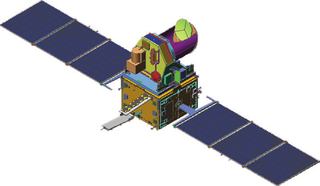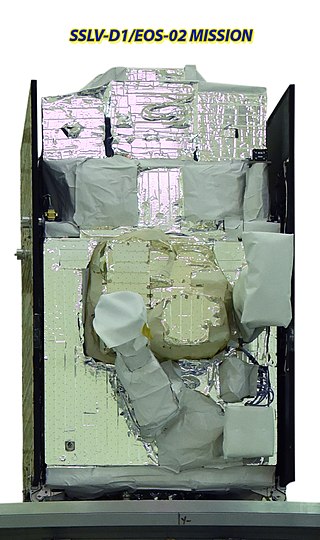
The Polar Satellite Launch Vehicle (PSLV) is an expendable medium-lift launch vehicle designed and operated by the Indian Space Research Organisation (ISRO). It was developed to allow India to launch its Indian Remote Sensing (IRS) satellites into Sun-synchronous orbits, a service that was, until the advent of the PSLV in 1993, only commercially available from Russia. PSLV can also launch small size satellites into Geostationary Transfer Orbit (GTO).

Cartosat-1 is a stereoscopic Earth observation satellite in a Sun-synchronous orbit, and the first one of the Cartosat series of satellites. The eleventh satellite of ISRO in Indian Remote Sensing Satellite (IRS) series. The satellite was launched by Indian Space Research Organisation and is operated by NTRO. Weighing around 1560 kg at launch, its applications will mainly be towards cartography in India.

Cartosat-3 is an advanced Indian Earth observation satellite built and developed by Indian Space Research Organisation (ISRO), which replaces the Indian Remote Sensing Satellite (IRS) series. It has a panchromatic resolution of 0.25 metres making it one of the imaging satellite with highest resolution in the world at the time of launch and MX of 1 metre with a high quality resolution which is a major improvement from the previous payloads in the Cartosat series.
The Integrated Space Cell was the nodal agency within the Government of India with oversight of the security of its space based military and civilian hardware systems. It was to be jointly operated by all the three services of the Indian Armed Forces, the civilian Defence Research and Development Organisation and the Indian Space Research Organisation (ISRO). This agency was superseded by Defence Space Agency in 2019.[better source needed]

Megha-Tropiques was a satellite mission to study the water cycle in the tropical atmosphere in the context of climate change. A collaborative effort between Indian Space Research Organisation (ISRO) and French Centre National d’Etudes Spatiales (CNES), Megha-Tropiques was successfully deployed into orbit by a PSLV rocket in October 2011.
The Cartosat is a series of Indian optical Earth observation satellites built and operated by the Indian Space Research Organisation (ISRO). The Cartosat series is a part of the Indian Remote Sensing Program. They are used for Earth's resource management, defence services and monitoring.

EOS-04 or Earth Observation Satellite - 04 is an Indian Space Research Organisation Radar Imaging Satellite designed to provide high-quality images under all weather conditions for applications such as Agriculture, Forestry & Plantations, Soil Moisture & Hydrology and Flood mapping. It is a follow on to RISAT-1 satellite with similar configuration. The satellite is developed by the ISRO and it is the sixth in a series of RISAT satellites.
Cartosat-2E is an Earth observation satellite developed by the Indian Space Research Organisation (ISRO), and is the seventh in the Cartosat series. It is designed to collect high-resolution, large-scale imagery for use in urban planning, infrastructure development, utilities planning, and traffic management.
PSLV-C38 was the 40th mission of the Indian Polar Satellite Launch Vehicle (PSLV) program and its 17th mission in the XL configuration. PSLV-C38 successfully carried and deployed 31 satellites in Sun-synchronous orbit. It was launched on 23 June 2017 by the Indian Space Research Organisation (ISRO) from the Satish Dhawan Space Centre at Sriharikota, Andhra Pradesh.
PSLV-C40 was the 42nd mission of the Indian Polar Satellite Launch Vehicle (PSLV) program in the XL configuration. PSLV-C40 successfully carried and deployed 31 satellites in Sun-synchronous orbits.

Cartosat-2F is the eighth satellite in the Cartosat-2 Series. It is an Earth observation satellite launched on the PSLV-C40 mission by the Indian Space Research Organisation (ISRO).

HySIS is an Earth observation satellite which will provide hyperspectral imaging services to India for a range of applications in agriculture, forestry and in the assessment of geography such as coastal zones and inland waterways The data will also be accessible to India's defence forces.

Microsat-R was claimed to be an experimental imaging satellite manufactured by DRDO and launched by Indian Space Research Organisation on 24 January 2019 for military use. The satellite served as a target for an anti-satellite test on 27 March, 2019.

The PSLV-C44 was the 46th mission of the Indian Polar Satellite Launch Vehicle (PSLV) program. It was the first flight of PSLV-DL, having 2 strap-on boosters and placed a primary payload Microsat-R and a secondary payload of Kalamsat V2 in Sun-synchronous orbits.

RISAT-2BR1 is a synthetic-aperture radar (SAR) imaging satellite built by Indian Space Research Organisation (ISRO). It is part of India's RISAT series of SAR imaging satellite and fourth satellite in the series. RISAT-2BR1 was launched on 11 December 2019 at 09:55 UTC aboard Polar Satellite Launch Vehicle PSLV-C48 from First Launch Pad (FLP) of Satish Dhawan Space Centre. It was the 50th launch of Polar Satellite Launch Vehicle and 75th launch from Satish Dhawan Space Centre.

EOS-02 was an Indian Earth observation microsatellite developed by the Indian Space Research Organisation as a test payload on the maiden launch of the Small Satellite Launch Vehicle (SSLV). EOS-02 was based on Microsat-TD. The objective behind EOS-02 was to realize and fly an experimental imaging satellite with short turnaround time to showcase launch on demand capability.












